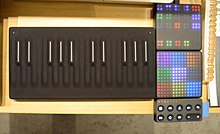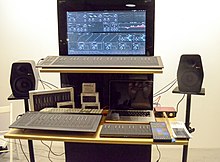
An electronic musical instrument or electrophone is a musical instrument that produces sound using electronic circuitry. Such an instrument sounds by outputting an electrical, electronic or digital audio signal that ultimately is plugged into a power amplifier which drives a loudspeaker, creating the sound heard by the performer and listener.

MIDI is a technical standard that describes a communications protocol, digital interface, and electrical connectors that connect a wide variety of electronic musical instruments, computers, and related audio devices for playing, editing, and recording music. The specification originates in the paper Universal Synthesizer Interface published by Dave Smith and Chet Wood of Sequential Circuits at the 1981 Audio Engineering Society conference in New York City. A MIDI recording is not an audio signal, as with a sound recording made with a microphone. It is more like a piano roll, indicating the pitch, start time, stop time and other properties of each individual note, rather than the resulting sound.
A music sequencer is a device or application software that can record, edit, or play back music, by handling note and performance information in several forms, typically CV/Gate, MIDI, or Open Sound Control (OSC), and possibly audio and automation data for DAWs and plug-ins.

A sampler is an electronic or digital musical instrument which uses sound recordings of real instrument sounds, excerpts from recorded songs or found sounds. The samples are loaded or recorded by the user or by a manufacturer. These sounds are then played back by means of the sampler program itself, a MIDI keyboard, sequencer or another triggering device to perform or compose music. Because these samples are usually stored in digital memory, the information can be quickly accessed. A single sample may often be pitch-shifted to different pitches to produce musical scales and chords.

An electronic keyboard, portable keyboard, or digital keyboard is an electronic musical instrument, an electronic derivative of keyboard instruments. Electronic keyboards include synthesizers, digital pianos, stage pianos, electronic organs and digital audio workstations. In technical terms, an electronic keyboard is a synthesizer with a low-wattage power amplifier and small loudspeakers.

GarageBand is a line of digital audio workstations developed by Apple Inc. for macOS, iPadOS, and iOS devices that allows users to create music or podcasts. GarageBand is developed by Apple for macOS, and was once part of the iLife software suite, along with iMovie and iDVD. Its music and podcast creation system enables users to create multiple tracks with pre-made MIDI keyboards, pre-made loops, an array of various instrumental effects, and voice recordings.
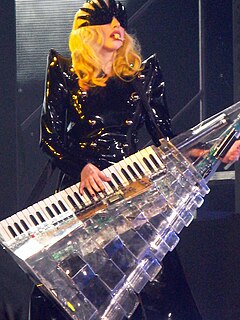
The keytar is a lightweight synthesizer that is supported by a strap around the neck and shoulders, similar to the way a guitar is supported by a strap. Keytars allow players a greater range of movement onstage, compared to conventional keyboards, which are placed on stationary stands or which are part of heavy, floor-mounted structures. The instrument has a musical keyboard for triggering musical notes and sounds. Various controls are placed on the instrument's "neck", including those for pitch bends, vibrato, portamento, and sustain.

A MIDI controller is any hardware or software that generates and transmits Musical Instrument Digital Interface (MIDI) data to MIDI-enabled devices, typically to trigger sounds and control parameters of an electronic music performance. They most often use a musical keyboard to send data about the pitch of notes to play, although a MIDI controller may trigger lighting and other effects. A wind controller has a sensor that converts breath pressure to volume information and lip pressure to control pitch. Controllers for percussion and stringed instruments exist, as well as specialized and experimental devices. Some MIDI controllers are used in association with specific digital audio workstation software. The original MIDI specification has been extended to include a greater range of control features.

A sound module is an electronic musical instrument without a human-playable interface such as a piano-style musical keyboard. Sound modules have to be operated using an externally connected device, which is often a MIDI controller, of which the most common type is the musical keyboard. Another common way of controlling a sound module is through a sequencer, which is computer hardware or software designed to record and playback control information for sound-generating hardware. Connections between sound modules, controllers, and sequencers are generally made with MIDI, which is a standardized interface designed for this purpose.

A MIDI keyboard or controller keyboard is typically a piano-style electronic musical keyboard, often with other buttons, wheels and sliders, used for sending MIDI signals or commands over a USB or MIDI 5-pin cable to other musical devices or computers. MIDI keyboards lacking an onboard sound module cannot produce sounds themselves, however some models of MIDI keyboards contain both a MIDI controller and sound module, allowing them to operate independently. When used as a MIDI controller, MIDI information on keys or buttons the performer has pressed is sent to a receiving device capable of creating sound through modeling synthesis, sample playback, or an analog hardware instrument. The receiving device could be:

The Continuum Fingerboard or Haken Continuum is a music performance controller and synthesizer developed by Lippold Haken, a professor of Electrical and Computer Engineering at the University of Illinois, and sold by Haken Audio, located in Champaign, Illinois.
Arturia is a French electronics company founded in 1999 and based in Grenoble, France. The company designs and manufactures audio interfaces and electronic musical instruments, including software synthesizers, drum machines, analog synthesizers, MIDI controllers, sequencers, and mobile apps.

Clavia Digital Musical Instruments is a Swedish manufacturer of virtual analog synthesizers, virtual electromechanical pianos and stage pianos, founded in Stockholm, Sweden in 1983 by Hans Nordelius and Mikael Carlsson. Since 1995, Clavia's keyboards have been branded Nord.
Polyphony is a property of musical instruments that means that they can play multiple independent melody lines simultaneously. Instruments featuring polyphony are said to be polyphonic. Instruments that are not capable of polyphony are monophonic or paraphonic.

A wind controller, sometimes referred to as a wind synthesizer, is an electronic wind instrument. It is usually a MIDI controller associated with one or more music synthesizers. Wind controllers are most commonly played and fingered like a woodwind instrument, usually the saxophone, with the next most common being brass fingering, particularly the trumpet. Models have been produced that play and finger like other acoustic instruments such as the recorder or the tin whistle. The most common form of wind controller uses electronic sensors to convert fingering, breath pressure, bite pressure, finger pressure, and other gesture or action information into control signals that affect musical sounds. The control signals or MIDI messages generated by the wind controller are used to control internal or external devices such as analog synthesizers or MIDI-compatible synthesizers, synth modules, softsynths, sequencers, or even non-instruments such as lighting systems.
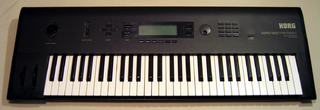
The Korg Wavestation is a vector synthesis synthesizer first produced in the early 1990s and later re-released as a software synthesizer in 2004. Its primary innovation was Wave Sequencing, a method of multi-timbral sound generation in which different PCM waveform data are played successively, resulting in continuously evolving sounds. The Wavestation's "Advanced Vector Synthesis" sound architecture resembled early vector synths such as the Sequential Circuits Prophet VS.

A guitar synthesizer is any one of a number of musical instrument systems that allow a guitarist to access synthesizer capabilities.

A synthesizer is an electronic musical instrument that generates audio signals. Synthesizers typically create sounds by generating waveforms through methods including subtractive synthesis, additive synthesis and frequency modulation synthesis. These sounds may be altered by components such as filters, which cut or boost frequencies; envelopes, which control articulation, or how notes begin and end; and low-frequency oscillators, which modulate parameters such as pitch, volume, or filter characteristics affecting timbre. Synthesizers are typically played with keyboards or controlled by sequencers, software or other instruments, and may be synchronized to other equipment via MIDI.
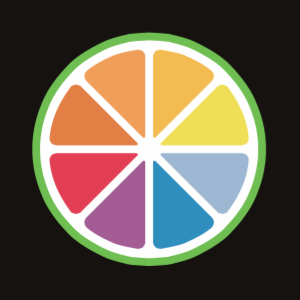
JUCE is an open-source cross-platform C++ application framework, used for the development of desktop and mobile applications. JUCE is used in particular for its GUI and plug-ins libraries. It is dual licensed under the GPLv3 and a commercial license.

The Seaboard is a musical keyboard-style MIDI controller manufactured by the British music technology company ROLI. It has a continuous sensor-embedded flexible rubber surface for playing the keys instead of traditional lever-style "moving keys". Some models, like the RISE Seaboard Grand, have an onboard sound engine. It has what the manufacturer calls "5D technology" which consists of five types of responsiveness to player actions: "strike", "glide" and "press", front to rear movement "slide" sensitivity, and release–velocity "lift". These responsiveness tools can be used to play the Seaboard with microtonal pitch bend sounds, by moving the finger from note to note, or trigger a vibrato effect into a string patch just by wiggling the finger, which would not be possible on a traditional MIDI controller using only the keys. The Seaboard also features polyphonic aftertouch, and a built-in USB- charged battery. There are three Seaboard models: the small minikey BLOCK, the RISE, and the GRAND, an 88-key keyboard with an onboard sound engine.

